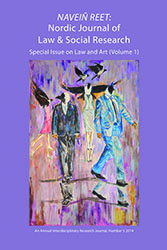Spatial Justice and Street Art
DOI:
https://doi.org/10.7146/nnjlsr.v0i5.111084Abstract
This article presents the notion of spatial justice as a way of considering the relationship between law and street art in a manner beyond the legal/illegal dichotomy. Through a series of empirical examples, it is demonstrated how street art literally takes a place already taken and imposes itself in an already appropriated urban public space. Street art thus redefines the space in contestation to law. However, street art is ephemeral and its taking of space is not permanent. Street art points to an alternative spatial definition, one of spatial justice, before – and, indeed, while – withdrawing from the space it occupies. Street art creates a rupture in the lawscape which makes explicit the presence and claims of law, thereby also making the need for law’s other – justice – pronounced. The question of relationality between law and street art which we bring forth in the present article plays itself out as a production of space and spatial justice in an exchange of place-taking, withdrawal and pronounciation. Spatial justice, as we perceive it here, is thus a way of thinking about law and street art not simply as polar opposites, but rather as co-dependent and bound together in an ongoing process of oscillation, mutual reinforcement and creativity.
References
Bengtsen Peter ‘Just Gardens? On the struggle for space and spatial justice’ (2014a) 39 Australian Feminist Law Journal 79.
Bengtsen Peter The Street Art World Almendros de Granada Press Lund 2014b.
Bruncevic Merima Fixing the Shadows: Access to Art and the Legal Concept of Cultural Commons, Juridiska institutionens skriftserie Göteborg 2014.
Derrida Jacques ‘Force of Law: “The Mystical Foundations of Authority”’ (1990) 11 Cardozo Law Review 920–1045.
Dickinson Maggie ‘The Making of Space, Race and Place: New York City’s War on Graffiti, 1970–the present’ (2008) 28 Critique of Anthropology 27–45.
Edwards Ian ‘Banksy’s Graffiti: A Not-so-simple Case of Criminal Damage?’ (2009) 73.4 The Journal of Criminal Law 345-361.
Good Max Vigilante Vigilante. The Battle for Expression. Open Ranch Productions 2011.
Lerman Celia ‘Protecting Artistic Vandalism: Graffiti and Copyright Law’ (2013) 2 N.Y.U. Journal of Intellectual Property and Entertainment Law 295–337.
Lewisohn Cedar Street Art: The Graffiti Revolution Tate Publishing London 2008.
Massey Doreen For Space Sage London 2005.
Philippopoulos-Mihalopoulos Andreas Law and the City Rutledge-Cavendish London 2007.
Philippopoulos-Mihalopoulos Andreas ‘Law’s Spatial Turn: Geography, Justice and a Certain Fear of Space’ (2010a) 7 Law, Culture and the Humanities 187.
Philippopoulos-Mihalopoulos Andreas ‘Spatial Justice: Law and the Geography of Withdrawal’ (2010b) 6 International Journal of Law in Context 201.
Philippopoulos-Mihalopoulos Andreas ‘Atmospheres of law: Senses, affects, lawscapes’ (2012) xxx Emotion, Space and Society 1.
Philippopoulos-Mihalopoulos Andreas ‘Mapping the Lawscape: Spatial Law and the Body’ in Bankowski Zenon, Del Mar Maksymilian & Maharg Paul (eds) The Arts and the Legal Academy: Beyond Text in Legal Education Ashgate Farnham 2013 119.
Riggle Nicholas Alden ‘Street Art: The Transfiguration of the Commonplaces’ (2010) 68 The Journal of Aesthetics and Art Criticism 243-257.
Smith Cathy Y. N. ‘Street Art: An Analysis Under U.S. Intellectual Property’s “Negative Space” Theory’ (2014) 24 Journal of Art, Technology and Intellectual Property Law 259– 293.
Young Alison ‘Criminal Images: The affective judgment of graffiti and street art’ (2012) 8 Crime, Media, Culture 297–314.
Published
How to Cite
Issue
Section
License
Counting from number 12 (2022), articles published in NNJLSR are licensed under Attribution 4.0 International (CC BY 4.0). Readers are allowed to copy and redistribute the articles in any medium or format, to adapt and revise the articles, and use the articles for commercial purposes, provided that the readers give appropriate credits.
No Creative Commons licenses are applied on articles in number 1 (2009)-11 (2021). All rights reserved by the authors. Readers are allowed to download, read, and link to the articles published in volume 1 (2009)-11 (2021), but they may not republish or redistribute these articles without permission of the authors.

